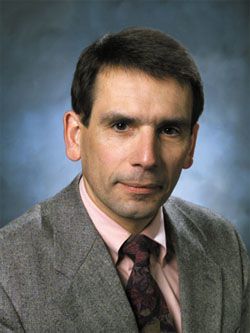Van Bibber charts new career course
 (Download Image)
Karl van Bibber
(Download Image)
Karl van Bibber
The Laboratory's Karl van Bibber has been tapped to be the vice-president and dean of research of the Monterey-based Naval Postgraduate School (NPS).
A senior scientist in the Physical and Life Sciences Directorate and a 23-year LLNL employee, van Bibber will assume his new academic post on Jan. 12.
For van Bibber, 58, the position offers a "golden opportunity" to return to academia, where he worked for six years as an assistant professor of physics at Stanford University before joining LLNL.
"It was always in my mind to go back to academia for the last phase of my career," he said.
"I actually received a phone call out of the blue from the school, inviting me to apply," he said. "It only took two seconds to realize that this was the perfect opportunity to carry out my academic interests within a national security context. The Laboratory, the NPS and UC Santa Barbara have a memorandum-of-understanding to collaborate in developing national security and homeland security-relevant technologies."
In van Bibber’s view, the potential synergies from this three-way collaboration are enormous.
As the NPS’ vice-president of research, van Bibber will oversee the university’s research, which is essentially conducted within the campus’ four institutes — the National Security Institute, the Cebrowski Institute for Information Sciences, the Meyer Institute for Systems Engineering and the Modeling, Virtual Environments and Simulation Institute (MOVES).
He will work with the academic deans of NPS’ four schools — Engineering and Applied Science, Organizational and Information Sciences, Business and Public Policy and International Studies — to expand the civilian Ph.D. program, a major strategic goal.
Leonard Ferrari, the NPS provost, and Cherry Murray, the Lab’s principal associate director for Science and Technology, have been working closely to expand the collaborations between the university and LLNL, according to van Bibber.
Nuclear engineer Craig Smith is the "LLNL Chair Professor" at NPS and T.R. Koncher, the leader of LLNL’s National Security Office, sits on the executive board for NPS’ National Security Institute. In addition, there are a number of budding collaborations or facility sharing arrangements that have been undertaken, including:
- A collaboration between NPS, LLNL and first responders on maritime interdiction operations. In one of a series of exercises, they worked with the Port Authority of New York and New Jersey and New York City police and fire personnel to detect and interdict weapons of mass destruction on large and small vessels.
- A cooperative arrangement allowed NPS to perform advanced shaped-charge testing for the U.S. Navy at LLNL’s High Explosives Application Facility.
- NPS permitted the Laboratory to use its facilities to test ultra-wideband communication technologies.
- NPS graduate students are doing their thesis work at LLNL while conducting research on topics such as the use of Raman spectroscopy to detect high explosives.
Next year, the NPS will celebrate its centennial and in van Bibber’s estimation, the school is emerging as a major R&D institution. With 700 faculty and 2,500 students, the university trains U.S. military line officers and officers from 60 nations.
During his LLNL career, van Bibber founded and led the high-energy physics and accelerator technology group, was deputy director for the Lab’s Science and Technology Office (now called the Institutional Science and Technology Office) and was the chief scientist for Physical Sciences.
Though he will soon assume his new post in Monterey, van Bibber plans to maintain an office in Physical and Life Sciences and will return to the Lab frequently.
"If we’re successful, there will be a major increase in NPS students writing their master’s and doctoral theses within the signature Lab programs," he said. "I also foresee strong program growth benefitting both the school and the Laboratory."
Prime areas include cybersecurity, National Ignition Facility weapons effect testing, free-electron laser and railgun research for the U.S. Navy’s electric ship initiative, sea-based antineutrino monitoring of reactors, and leveraging NPS’s satellite design and deployment capability for space situational awareness.




